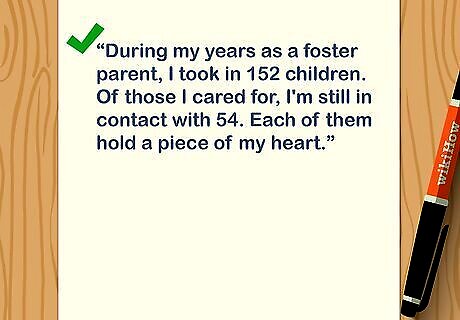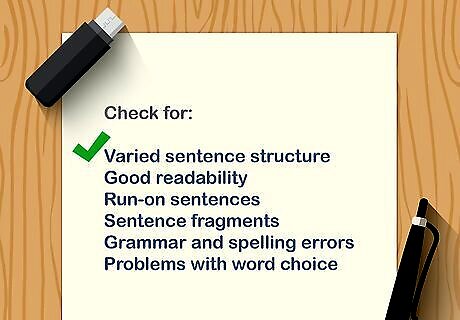
views
Drafting Your Preface

Describe your background. This gives the reader a chance to get to know you. In many cases, this is your only chance to address the reader! Include your educational and professional background. Pay special attention to details that pertain to the subject of your work. Provide your credentials if they’re important to the topic. For example, when writing a book about bipolar disorder, it would be helpful to explain your professional and educational background as a psychiatrist. To keep this section informal, you might decide to do this in the form of an anecdote. For instance, “As I earned my degrees in psychology, I began to recognize the importance of pharmaceuticals for managing mental illness, so I pursued a medical degree. In my ten years of practice, I’ve treated over a hundred patients with bipolar disorder, most of whom are able to manage their condition with medication and counseling.” For a memoir you might write, "Becoming a foster parent changed my life and the lives of the children who came to live with me. I thought I would be helping them, but through caring for them I gained a lot, as well."

Discuss what inspired the writing project or your research, if applicable. The reader might be interested in knowing what or who prompted you to choose this particular topic. Similarly, you might want to share your inspiration because it will help people understand the purpose of your work. However, it’s not necessary to provide an inspiration. You could write, “After watching so many of my patients make a complete turnaround, I realized that my treatment strategies could be used to help others. I decided to write this book to help other mental health professionals treat their patients using my methods.” For a nonfiction historical text, you could write, "Ancient Egypt has interested me since I first watched The Mummy as a small child. After years of research, I finally have knowledge of my own to contribute." If you're writing a memoir you might write, "After sharing my experiences with others through outreach efforts, I realized I could help others with my life story."

Tell the reader why your text is important. Why should the reader read your text? What makes your work valuable? Explain the answers to these questions in your preface. This helps the reader understand the gaps in research you’re filling, or what they might gain from reading your work. For instance, “My treatment methods focus on an integrated, holistic approach that differs from many treatment protocols,” or "Through my research, I've gained a new perspective on the pyramids of Giza that I will share through this book." If you're writing a memoir, you could say, "As an avid reader, I recognized that there weren't many stories out there like mine."

Explain who your target audience is. This helps your reader understand if your work is right for them. While you might want as many readers as possible, letting them know who your work is for ahead of time can help you avoid disappointing people. For example, “I wrote this book for mental health professionals, but individuals who’ve been diagnosed with bipolar disorder may also find it helpful,” or "This book is for all of the history buffs like myself." If you're writing a memoir, you might say, "This book is for everyone who's struggling to find their place in the world."

Give the reader an idea of what to expect from your text. This helps shape your reader’s expectations. Additionally, it will help them know what to pay attention to as they read. Overall, it can help you more effectively convey your message. For example, “This book will explain my treatment methods and best practices. I also provide example exercises, as well as ten detailed case studies.” As another example, "While I was in Egypt, I collected stories as well as facts. I will share all of them with you, as well as the photos I took along the way." Your memoir preface might read, "In my book, I discuss both my experiences and how they changed me. You'll find stories and mementos that I hope will touch your heart."

Offer interesting insights about your work. While it’s not required, you might want to include extra details about your work. Perhaps you think the reader will enjoy them, or maybe you think they’ll help the reader better understand your work. If you have any interesting insights to share, your preface is the place to do so. For example, “Before writing this book, I published eight peer-reviewed papers about my work with patients," or "Among my photos is a mummy who had never been photographed." Your memoir might include, "During my years as a foster parent, I took in 152 children. Of those I cared for, I'm still in contact with 54. Each of them hold a piece of my heart." As an example, you could read over the preface to Oscar Wilde's The Picture of Dorian Gray. Although his novel is a work of fiction, Wilde includes a preface to provide the reader with a series of contradictory statements that inspired his work.

Include your acknowledgements, if you prefer. You might honor the people who helped with your research, writing, or editing. For example, you might acknowledge your research committee, if you had one. You might write, “I want to give a special thanks for Sarah Lopez, who served as my research assistant throughout this project,” or "I'd like to give a special thanks to my host family in Egypt who has been my rock throughout three research visits." For a memoir, you might write, "Thank you to my family for supporting me throughout the years, and thank you to each child who has let me be their foster mother." You should only include your acknowledgements if you have a few people to honor. If you have several, it’s best to create a separate acknowledgements section.
Revising Your Preface

Review your preface to look for areas that need work. Good writing always involves revisions, so make sure you revise and edit your preface. Start by reviewing it yourself, making notes for improvements. Check for the following: Varied sentence structure Good readability Run-on sentences Sentence fragments Grammar and spelling errors Problems with word choice

Ask a trusted friend or colleague to review the preface. Other people are more likely to spot your errors than you are, as you know what you’re trying to say. A second set of eyes can help you identify passages that need extra work. Tell the person to write their feedback on your preface so you can go back and make corrections. If you’re working with a committee, ask one of the members to read over your preface.

Revise your preface according to the feedback. Use your own feedback and that of the person you asked to review your work. Rewrite passages that need help, as well as any run-on sentences or sentence fragments. When you can, substitute better word choices. Finally, correct any spelling and grammar errors. You may want to revise your preface several times.

Proofread your preface. Watch for and fix typos. Keep an eye out for words that are spelled right but used incorrectly, such as “then” versus “than.” Additionally, correct any grammar and spelling issues. You may also want to get someone else to proofread your preface, as they’ll be able to better spot typos and mistakes. It’s often harder to detect your own errors.
Writing an Effective Preface

Write your preface only after you've written your book or paper. It's difficult to know what to include in your preface if you haven't finished writing your text. In fact, you'll likely find it easy to write your preface once the rest of the text is written. Save your preface for last! If you write your preface before you write the text, you'll likely need to rework it once your book or paper is finished.

Check the formatting requirements for your publication. You may be writing a preface for a book, article, academic paper, or similar text. Each of these different publications have different formatting requirements, so make sure you follow the right ones. If you’re working with a publisher, ask them for the correct formatting. For a journal article or research paper, check the submission guidelines or contact the editor. If you’re writing an academic thesis or dissertation, check with your school or committee to get the specific format they prefer. You may also be able to access a template.

Address the reader directly. A preface is different from other parts of your text. Usually it’s much more informal, as though you’re having a conversation with the reader before they start reading your text. Use your preface as an opportunity to connect with the reader. For example, “I intended my research to help you, the reader, approach the field of robotics from a new angle.”

Avoid putting essential information only in the preface. It’s likely that many readers will skip over your preface. That means your reader may overlook important information if it’s provided in the preface. Make sure this information is also provided later in the text. For example, you might want to include background on your topic that inspired you to conduct this research project. This is okay as long as you also include the information in the proper section of your text.

Keep your preface under two pages in most cases. It’s best to keep a preface short and concise, writing directly to the point. It’s not a place for flowery language or extra details. However, there are some instances when you might have a long background story that the reader may enjoy or take something from, so your preface could be longer if necessary. For example, you might be writing a book that’s based on decades of research or that sprang out of an interesting incident. If this is the case, you might decide to write a longer preface to share this with the reader. This is a judgment call you’ll have to make for yourself.




















Comments
0 comment